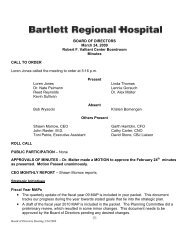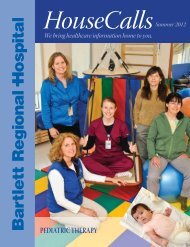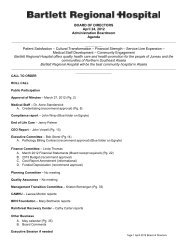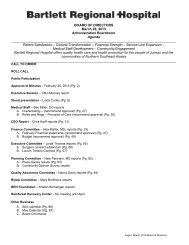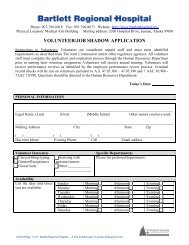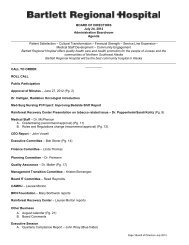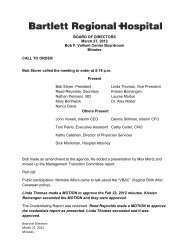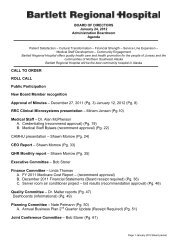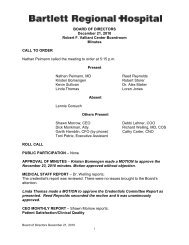Newsletter - Bartlett Regional Hospital
Newsletter - Bartlett Regional Hospital
Newsletter - Bartlett Regional Hospital
You also want an ePaper? Increase the reach of your titles
YUMPU automatically turns print PDFs into web optimized ePapers that Google loves.
and assisted Bill Palmer in finishing a<br />
surgical procedure necessary to stabilize<br />
a patient. You don’t get any better<br />
than Palmer; same goes for [Dr. Allan]<br />
Schlicht,” he says of two long-time<br />
Juneau surgeons. “Bob Urata—an excellent<br />
physician and a superb leader—I’d<br />
have no problem with him taking care<br />
of my family. Sure, for normal medical<br />
care, Juneau residents can come down<br />
to Seattle, but you certainly don’t have<br />
to.”<br />
There are circumstances in which a<br />
patient needs to be transferred to a large<br />
medical center, Dr. Copass explains,<br />
such as someone suffering multiple<br />
traumatic injuries that would require<br />
the efforts of several surgeons working<br />
simultaneously or a patient who is in<br />
need of more intensive or specialty care<br />
than a community hospital and its staff<br />
can provide. “Some patients need to be<br />
transferred. It can be a very hard thing<br />
for a doctor to say ‘I can’t do it.’ You spend<br />
your entire career saying ‘I can do it.’ ” In<br />
Dr. Copass’s estimation, it is the physician<br />
who recognizes the limitations of<br />
the resources immediately available and<br />
makes the call for a medivac who lives up<br />
to the highest standards of the profession.<br />
As for Jason, his immediate and extended<br />
family are forever thankful that Dr. Richard<br />
Welling made that call. Several days<br />
after Jason and his mother took off from<br />
Juneau in an Airlift Northwest Learjet,<br />
his life very much in the balance, Jason<br />
returned home to be greeted at the<br />
arrival gate by a crowd of uncles, aunts,<br />
and cousins. If anyone were in doubt as<br />
to his recovery, Jason put that to rest by<br />
leaving his parents and brother in his<br />
wake as he bounded through the airport<br />
exit, arms reaching out just before he<br />
leapt into the embrace of a loving family.<br />
Antibiotic Resistant Microbes<br />
Preventing infections<br />
Jan Beauchamp, <strong>Bartlett</strong>’s Infection Prevention Coordinator, has declared<br />
the “Hand Hygiene Fair” a great success. “People were really having a blast.<br />
We had every participating health care worker make a pledge to ‘practice<br />
what I learned in kindergarten’ each and every day.” Following the pledge,<br />
which included the promise to wash hands before and after every patient<br />
contact, each person traced a hand outline and then signed it.<br />
Held in August, the Hand Fair was repeated throughout the week to coincide<br />
with each shift. While a fun event, it underlined a serious concern: healthcare<br />
acquired infection.<br />
The good news is that <strong>Bartlett</strong> has one of the lowest rates of infection of any<br />
similar hospital in the country. The bad news is that infection by Staphylococcus<br />
is, well, bad news.<br />
Staph is a common bacteria—one in<br />
four people will test positive with a skin<br />
swab. In most cases, such surface “colonizations”<br />
remain benign, but “if staph<br />
gets inside you, it can be a big problem,”<br />
says Beauchamp. An even bigger<br />
problem is the antibiotic resistant<br />
strain: methicillin-resistant Staphylococcus<br />
aureus, otherwise known as MRSA<br />
(MER-suh). About two out of 100 people<br />
carry MRSA.<br />
According to Beauchamp, MRSA first<br />
came to the attention of <strong>Bartlett</strong>’s health<br />
care providers in the 1990s. “People<br />
would come in to the emergency room<br />
complaining of infected spider bites.<br />
Jan Beauchamp administers a hand washing<br />
pledge to <strong>Bartlett</strong> employees.<br />
It turned out this was happening all over the county. Then someone wrote<br />
a paper and said, Hey, this isn’t spider bites, this is MRSA.” The infections<br />
looked similar: red angry boils with a hole in the center. “Pretty soon, we realized<br />
very few of the infections we were seeing were spider bites.”<br />
While MRSA can present challenges, Beauchamp says it is very uncommon<br />
that the condition can’t be resolved—although it is an unpleasant experience.<br />
“People get pretty sick. It goes from a pimple yesterday to a four-inch<br />
wide boil today. Get that and you’ll feel really ill.”<br />
The standard protocol for patients who show MRSA-like symptoms is to<br />
use isolation precautions. There are isolation rooms in both the Emergency<br />
Department and the Critical Care Unit. “If a patient is in the operating room,<br />
it doesn’t matter what the staph strain might be—it’s contagious. What they<br />
do is to schedule the operation for the last case of the day, using similar isolation<br />
procedures. Then they do an end of the day cleaning, taking extra<br />
precautions. We do everything we can to keep everything in room: gowns,<br />
gloves; it all stays in the operating room until collected and disposed.”<br />
15 — Fall 2011



